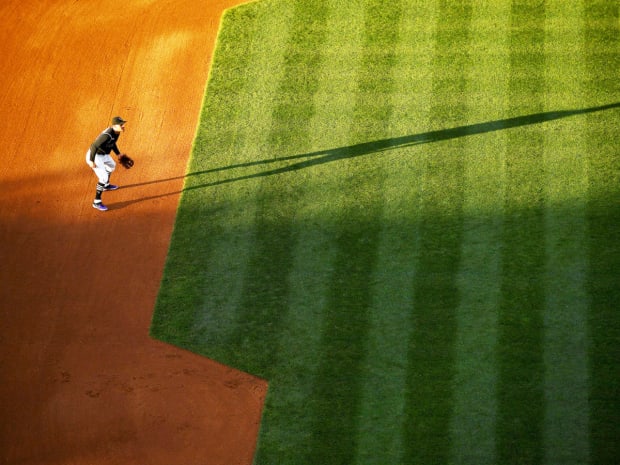It's hard to blame him for wanting out of Colorado. Now he can adjust to life away from Coors Field.
Mookie Betts, Francisco Lindor, Nolan Arenado. For the third time in less than a calendar year, a homegrown franchise superstar in his prime
is on the move. “Financial flexibility” and the dream of building “a sustainable winner” are more important than keeping a player who could wear your team’s cap all the way to Cooperstown.Viewed from the office of the accounting department, such trades have merit. And by trading Arenado to St. Louis, the baseball ops department of the Rockies will buy itself time, one of the game’s unspoken valued assets, as it concedes to the Dodgers and Padres. See the rolling rebuild going on in Seattle.
There is an argument to be made for Colorado's trading Arenado. I get it. I just don’t believe it makes the Rockies better—not now, not in the coming years. The Cardinals got themselves a steal, buying down Arenado’s cost to $22 million per year for his age-31–36 seasons. Arenado will pull them far ahead in a National League Central in which nobody else is trying very hard.
To believe the Rockies are better without Arenado you’d have to believe they will turn the $149 million they saved into gold. (They gave St. Louis $50 million to close the deal.) There is no indication that will happen. Playing at altitude is difficult enough. They Rockies never have won a division title. But it is especially hard when you make more poor decisions than good ones.
Arenado was traded in part because he was unhappy about how the team has been run. Can you blame him? Over the past three years Colorado signed one major league free agent: Daniel Murphy on his last legs.
Since Arenado made his first All-Star team in 2015, the Rockies have spent $281.6 million on 12 free agents. Virtually all of their decisions have been disasters. From breakout hitters without a position (Murphy, Ian Desmond) to veteran relievers on their way down (Wade Davis, Jake McGee, Bryan Shaw, Mike Dunn, Jason Motte, Chad Qualls) the Rockies have missed on all 12 free agents with the possible exception of a one-year, $2.6 million deal for Mark Reynolds, who was O.K.
They also are selling low on Arenado, trading him late in the offseason, off his worst season and during a pandemic. Maybe they believe he is on the decline. Putting faith in short-season metrics would be a dangerous assumption.
It is true that last season Arenado lost .149 off his slugging percentage, the 25th-worst decline in baseball. Here are some of the hitters with a worse decline: Christian Yelich (No. 1 at -.241), José Altuve (2 at -.206), Cody Bellinger (11 at -.174), Javier Báez (12 at -.171), Kris Bryant (14 at -.170) and J.D. Martinez (15 at -.168). Are you ready to give up on them after gerrymandered training schedules and a two-month sample?

Arenado seemed to wear his unhappiness on the field last season. He hit pop-ups at a career-high rate, let far more pitches in the strike zone go by without swinging (passivity was the biggest problem for Yelich as well) and even showed a significant drop in his sprint speed. He did play with inflammation in the AC joint of his left shoulder before he was shut down with a week to play. He also looked like someone who begged for the classic change-of-scenery prescription.
The Cardinals already had one of the best defenses in baseball, and now it’s ridiculously good with Arenado, one of the best defenders ever at his position. The key upgrade is on offense. The Cardinals hit the fewest home runs and were a bottom-four team in slugging. This is exactly the kind of bat they needed to cut the gap between them and the league’s elite teams—in order, the Dodgers, Padres, Braves and Mets.
One risk for St. Louis is it will be paying Goldschmidt $26 million per year and Arenado $22 million through their age-36 seasons. Goldschmidt is still an impact hitter, but his average exit velocity, hard contact rate and slugging have gone down slightly three straight years. But most contracts should not be judged by how smart they look as they run out; value is amortized as part of the cost of having the player in the first place. The Cardinals have Arenado and a chance to win. The Rockies have neither.
The recent run of trading homegrown franchise position players in their prime isn’t new, only condensed in their frequency. It happened with Babe Ruth (1918), Tris Speaker (1916), Rogers Hornsby (1926), Frank Robinson (1965), Rickey Henderson (1984) and Miguel Cabrera (2007). Most of those precedents are too ancient to have much bearing today.
It’s not hard to imagine that Arenado can bounce back to a level slightly below the .300/.362/.575 he averaged between 2015 and '19, assuming the shoulder is not a chronic problem. Coors Field is a great place to hit because the park is so large; there is too much square footage for defenses to cover. Losing Coors Field as a home field will most likely take a bite off his batting average.
But Arenado no longer will have to deal with the effects of yo-yoing between playing at mile-high altitude and everywhere else. Because altitude reduces the sharpness of breaking balls, sliders and curveballs on the road look like killer pitches after a 10-day homestand. It’s the downside to playing for the Rockies—constantly readjusting to reading the break on breaking pitches. You can see clearly the effects in this five-season sample from Arenado:
Arenado vs. Breaking Pitches, 2016–20
Lest you think Arenado is an anomaly, he’s not. The team’s splits over that time are even more dramatic, by a lot:
Rockies vs. Breaking Pitches, 2016–2020
Arenado turns 30 in April. He has been a Rockie ever since the club selected him in the second round of the 2009 draft. He does have opt-outs on the table after the 2021 and 2022 seasons, but the Cardinals have put together 13 straight winning seasons, during which they have reached the playoffs eight times. He has found that rare landing spot: a chance to win every year.
In eight years with the Rockies, Arenado has played on only two winning teams. He finished at least 16 games out of first place every year but one. It’s easy to imagine him liking his new digs as much as St. Louis fans will like watching him play every day.

0 Comments:
Post a Comment